Negative Pressure Wound Therapy with Instillation: Analysis of the Rinsing Fluid as a Monitoring Tool and Approach to the Inflammatory Process: A Pilot Study
Abstract
1. Introduction
2. Materials and Methods
3. Results
4. Discussion
Author Contributions
Funding
Institutional Review Board Statement
Informed Consent Statement
Data Availability Statement
Conflicts of Interest
References
- Mousavi, S.-M.; Nejad, Z.M.; Hashemi, S.A.; Salari, M.; Gholami, A.; Ramakrishna, S.; Chiang, W.-H.; Lai, C.W. Bioactive Agent-Loaded Electrospun Nanofiber Membranes for Accelerating Healing Process: A Review. Membranes 2021, 11, 702. [Google Scholar] [CrossRef] [PubMed]
- Mouës, C.M.; Vos, M.C.; Bemd, G.-J.C.M.V.D.; Stijnen, T.; Hovius, S.E.R. Bacterial load in relation to vacuum-assisted closure wound therapy: A prospective randomized trial. Wound Repair Regen. 2004, 12, 11–17. [Google Scholar] [CrossRef] [PubMed]
- Pliakos, I.; Michalopoulos, N.; Papavramidis, T.S.; Arampatzi, S.; Diza-Mataftsi, E.; Papavramidis, S. The Effect of Vacuum-Assisted Closure in Bacterial Clearance of the Infected Abdomen. Surg. Infect. 2014, 15, 18–23. [Google Scholar] [CrossRef] [PubMed]
- Yang, C.; Goss, S.G.; Alcantara, S.; Schultz, G.; Ii, J.C.L. Effect of Negative Pressure Wound Therapy With Instillation on Bioburden in Chronically Infected Wounds. Wounds 2017, 29, 240–246. [Google Scholar] [PubMed]
- Bradley, B.H.; Cunningham, M. Biofilms in Chronic Wounds and the Potential Role of Negative Pressure Wound Therapy: An integrative review. J. Wound Ostomy Cont. Nurs. 2013, 40, 143–149. [Google Scholar] [CrossRef]
- Gabriel, A.; Shores, J.; Heinrich, C.; Baqai, W.; Kalina, S.; Sogioka, N.; Gupta, S. Negative pressure wound therapy with instillation: A pilot study describing a new method for treating infected wounds. Int. Wound J. 2008, 5, 399–413. [Google Scholar] [CrossRef] [PubMed]
- Goss, S.; Schwartz, J.; Facchin, F.; Avdagic, E.; Gendics, C.; Lantis, J., 2nd. Negative Pressure Wound Therapy With Instillation (NPWTi) Better Reduces Post-debridement Bioburden in Chronically Infected Lower Extremity Wounds Than NPWT Alone. J. Am. Coll. Clin. Wound Spéc. 2012, 4, 74–80. [Google Scholar] [CrossRef] [PubMed]
- Kairinos, N.; Voogd, A.M.; Botha, P.H.; Kotze, T.; Kahn, D.; Hudson, D.A.; Solomons, M. Negative-Pressure Wound Therapy II: Negative-Pressure Wound Therapy and Increased Perfusion. Just an Illusion? Plast. Reconstr. Surg. 2009, 123, 601–612. [Google Scholar] [CrossRef]
- Kairinos, N.; Solomons, M.; Hudson, D.A. Negative-Pressure Wound Therapy I: The Paradox of Negative-Pressure Wound Therapy. Plast. Reconstr. Surg. 2009, 123, 589–598; discussion 599–600. [Google Scholar] [CrossRef]
- Kairinos, N.; Mc Kune, A.; Solomons, M.; Hudson, D.A.; Kahn, D. The flaws of laser Doppler in negative-pressure wound therapy research. Wound Repair Regen. 2014, 22, 424–429. [Google Scholar] [CrossRef]
- Kairinos, N.; Holmes, W.J.M.; Solomons, M.; Hudson, D.A.; Kahn, D. Does a Zone of Increased Perfusion Exist around Negative-Pressure Dressings? Plast. Reconstr. Surg. 2013, 132, 978–987. [Google Scholar] [CrossRef] [PubMed]
- Derrick, K.L.; Lessing, M.C. Genomic and Proteomic Evaluation of Tissue Quality of Porcine Wounds Treated With Negative Pressure Wound Therapy in Continuous, Noncontinuous, and Instillation Modes. Eplasty 2014, 14, e43. [Google Scholar] [PubMed]
- Li, X.; Liu, J.; Liu, Y.; Hu, X.; Dong, M.; Wang, H.; Hu, D. Negative pressure wound therapy accelerates rats diabetic wound by promoting agenesis. Int. J. Clin. Exp. Med. 2015, 8, 3506–3513. [Google Scholar] [PubMed]
- Wynn, M.; Freeman, S. The efficacy of negative pressure wound therapy for diabetic foot ulcers: A systematised review. J. Tissue Viability 2019, 28, 152–160. [Google Scholar] [CrossRef] [PubMed]
- Polykandriotis, E.; Horch, R.E.; Jost, M.; Arkudas, A.; Kees, F.; Schmitz, M. Can systemically administered antibiotics be detected in wound tissues and surfaces under negative pressure wound therapy? Int. Wound J. 2019, 16, 503–510. [Google Scholar] [CrossRef] [PubMed]
- Taeger, C.; Wallner, S.; Martini, T.; Schiltz, D.; Kehrer, A.; Prantl, L.; Biermann, N. Analysis of Rinsing Fluid during Negative Pressure Wound Therapy with Instillation: A Potential Monitoring Tool in Acute and Chronic Wound Treatment. A Pilot Study. Cells 2021, 10, 732. [Google Scholar] [CrossRef] [PubMed]
- Mouës, C.M.; Van Toorenenbergen, A.W.; Heule, F.; Hop, W.C.; Hovius, S.E.R. The role of topical negative pressure in wound repair: Expression of biochemical markers in wound fluid during wound healing. Wound Repair Regen. 2008, 16, 488–494. [Google Scholar] [CrossRef]
- Faes, S.; Hübner, M.; Demartines, N.; Hahnloser, D. Cytokine clearance in serum and peritoneal fluid of patients undergoing damage control surgery with abdominal negative pressure therapy for abdominal sepsis. Pleura Peritoneum 2021, 6, 31–38. [Google Scholar] [CrossRef]
- Jiang, W.G.; Sanders, A.J.; Ruge, F.; Harding, K.G. Influence of interleukin-8 (IL-8) and IL-8 receptors on the migration of human keratinocytes, the role of PLC-γ and potential clinical implications. Exp. Ther. Med. 2012, 3, 231–236. [Google Scholar] [CrossRef]
- Rennekampff, H.O.; Hansbrough, J.F.; Kiessig, V.; Dore, C.; Sticherling, M.; Schroder, J.M. Bioactive interleukin-8 is expressed in wounds and enhances wound healing. J. Surg. Res. 2000, 93, 41–54. [Google Scholar] [CrossRef]
- Meng, L.; Guo, X.; Yang, X.; Liu, H.; Yu, M.; Wu, Y.; Zhu, Z. Human α defensins promote the expression of the inflammatory cytokine interleukin-8 under high-glucose conditions: Novel insights into the poor healing of diabetic foot ulcers. J. Biochem. Mol. Toxicol. 2019, 33, e22351. [Google Scholar] [CrossRef] [PubMed]
- Gallucci, R.M.; Simeonova, P.P.; Matheson, J.M.; Kommineni, C.; Guriel, J.L.; Sugawara, T.; Luster, M.I. Impaired cutaneous wound healing in interleukin-6-deficient and immunosuppressed mice. FASEB J. 2000, 14, 2525–2531. [Google Scholar] [CrossRef] [PubMed]
- Gallucci, R.M.; Sugawara, T.; Yucesoy, B.; Berryann, K.; Simeonova, P.P.; Matheson, J.M.; Luster, M.I. Interleukin-6 Treatment Augments Cutaneous Wound Healing in Immunosuppressed Mice. J. Interf. Cytokine Res. 2001, 21, 603–609. [Google Scholar] [CrossRef] [PubMed]
- Lee, E.G.; Luckett-Chastain, L.R.; Calhoun, K.N.; Frempah, B.; Bastian, A.; Gallucci, R.M. Interleukin 6 Function in the Skin and Isolated Keratinocytes Is Modulated by Hyperglycemia. J. Immunol. Res. 2019, 2019, 5087847. [Google Scholar] [CrossRef] [PubMed]
- Blann, A.D.; Belgore, F.M.; McCOLLUM, C.N.; Silverman, S.; Lip, P.L.; Lip, G.Y.H. Vascular endothelial growth factor and its receptor, Flt-1, in the plasma of patients with coronary or peripheral atherosclerosis, or Type II diabetes. Clin. Sci. 2002, 102, 187–194. [Google Scholar] [CrossRef]
- Kikuchi, R.; Nakamura, K.; MacLauchlan, S.; Ngo, D.T.-M.; Shimizu, I.; Fuster, J.J.; Katanasaka, Y.; Yoshida, S.; Qiu, Y.; Yamaguchi, T.P.; et al. An antiangiogenic isoform of VEGF-A contributes to impaired vascularization in peripheral artery disease. Nat. Med. 2014, 20, 1464–1471. [Google Scholar] [CrossRef]
- Xuan, Y.H.; Bin Huang, B.; Tian, H.S.; Chi, L.S.; Duan, Y.M.; Wang, X.; Zhu, Z.X.; Cai, W.H.; Zhu, Y.T.; Wei, T.M.; et al. High-Glucose Inhibits Human Fibroblast Cell Migration in Wound Healing via Repression of bFGF-Regulating JNK Phosphorylation. PLoS ONE 2014, 9, e108182. [Google Scholar] [CrossRef] [PubMed]
- Siqueira, M.F.; Li, J.; Chehab, L.; Desta, T.; Chino, T.; Krothpali, N.; Behl, Y.; Alikhani, M.; Yang, J.; Braasch, C.; et al. Impaired wound healing in mouse models of diabetes is mediated by TNF-α dysregulation and associated with enhanced activation of forkhead box O1 (FOXO1). Diabetologia 2010, 53, 378–388. [Google Scholar] [CrossRef] [PubMed]
- Fahey, T.J.; Turbeville, T.; McIntyre, K. Differential TNF Secretion by Wound Fibroblasts Compared to Normal Fibroblasts in Response to LPS. J. Surg. Res. 1995, 58, 759–764. [Google Scholar] [CrossRef]

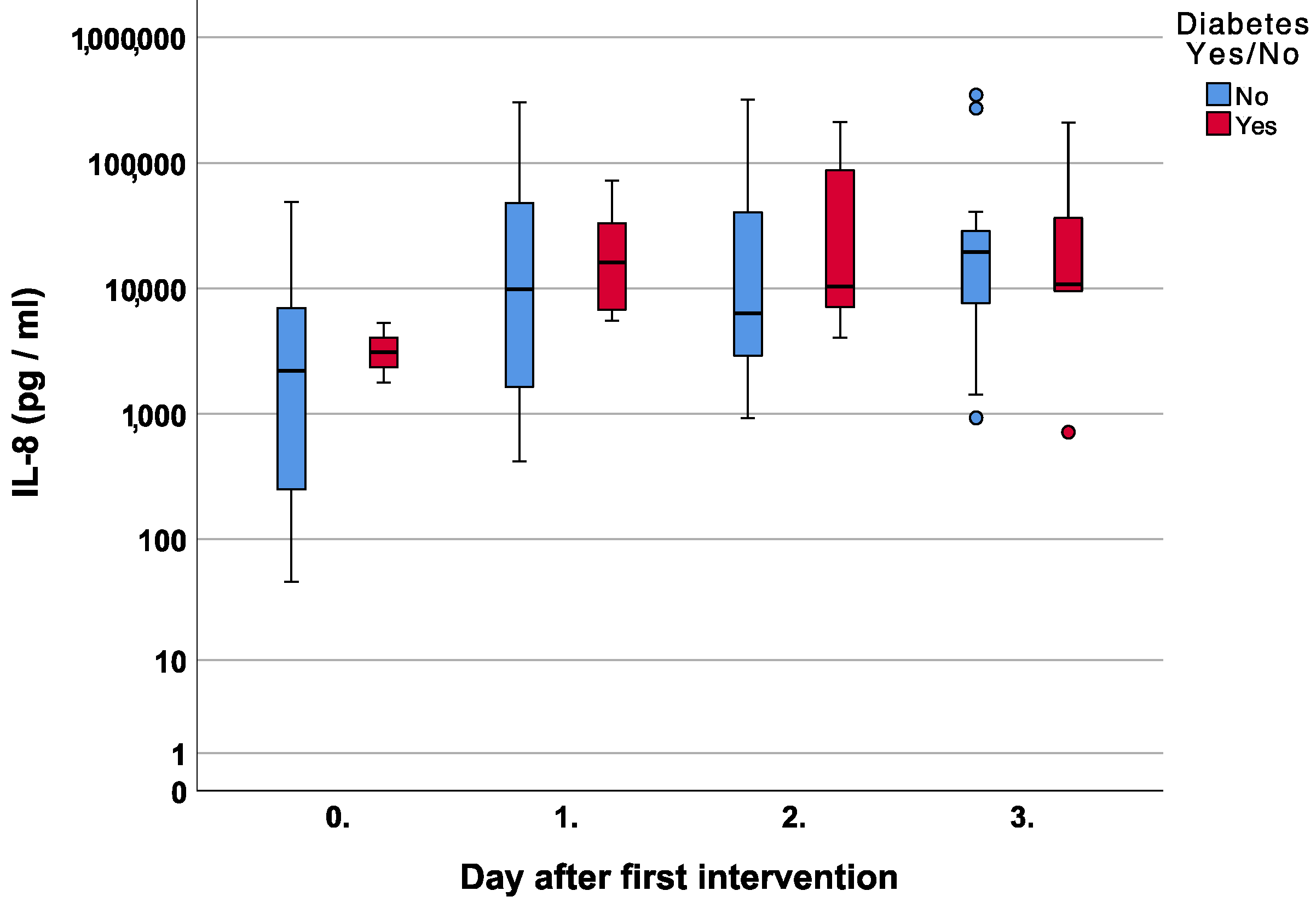
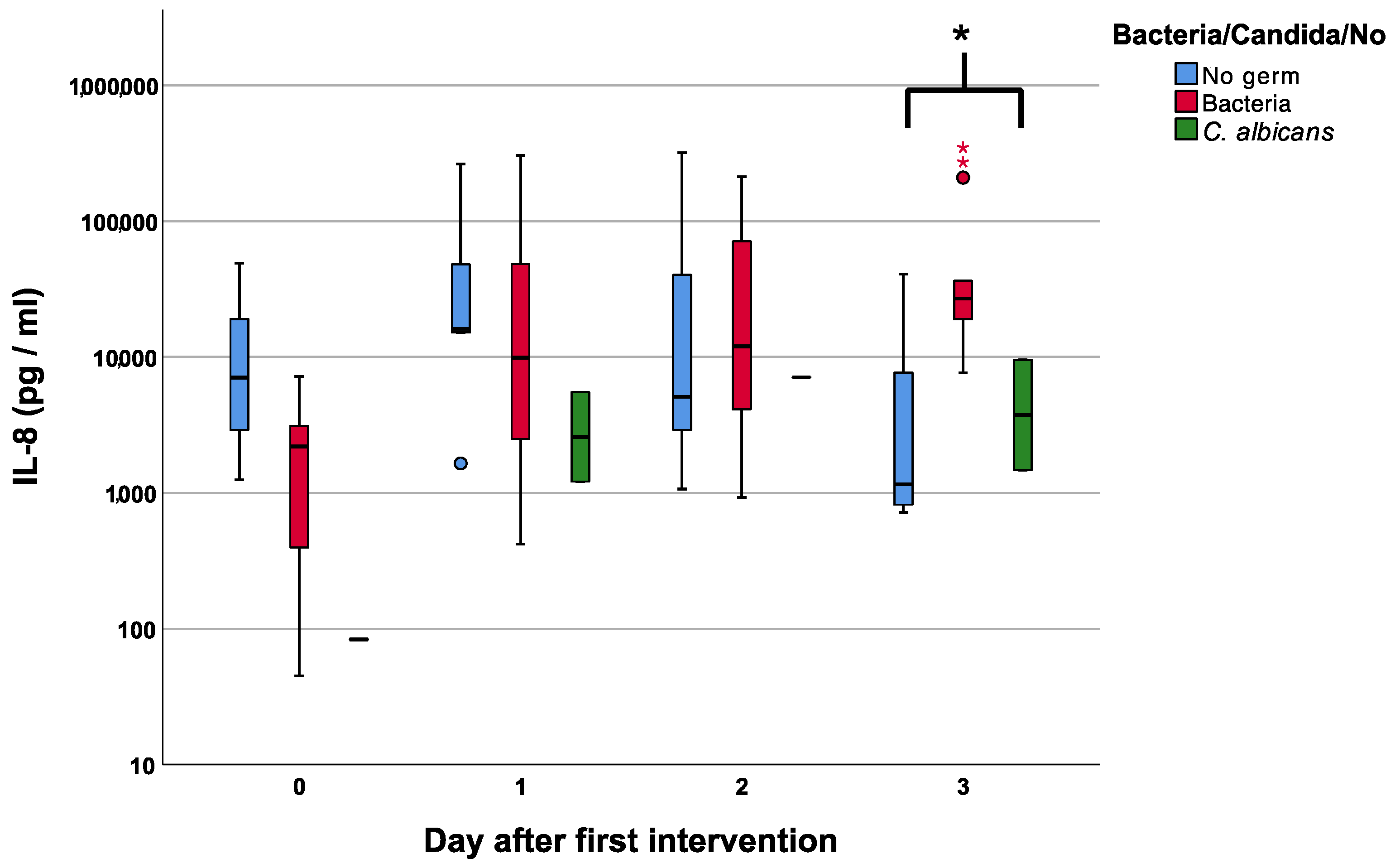
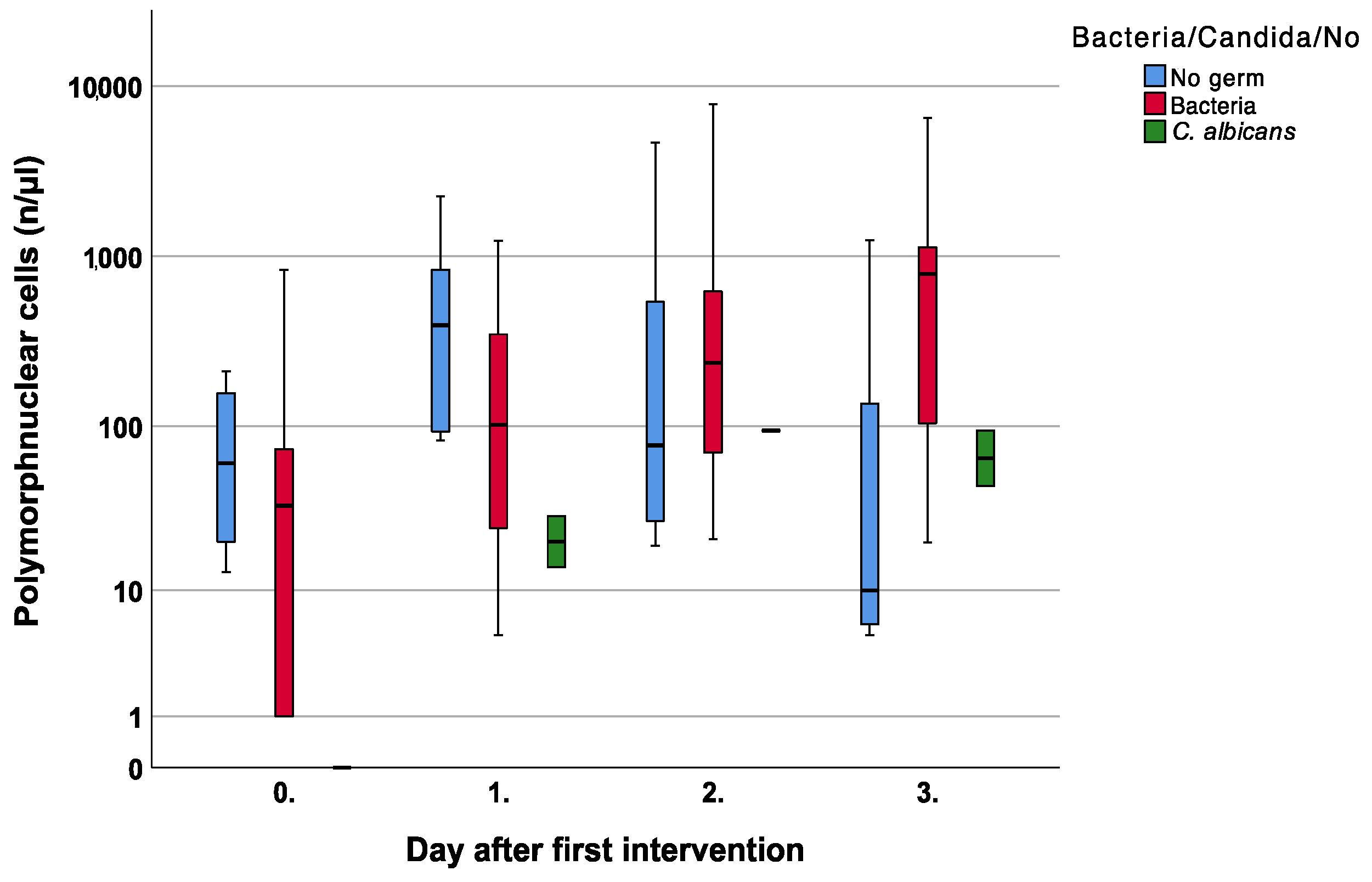
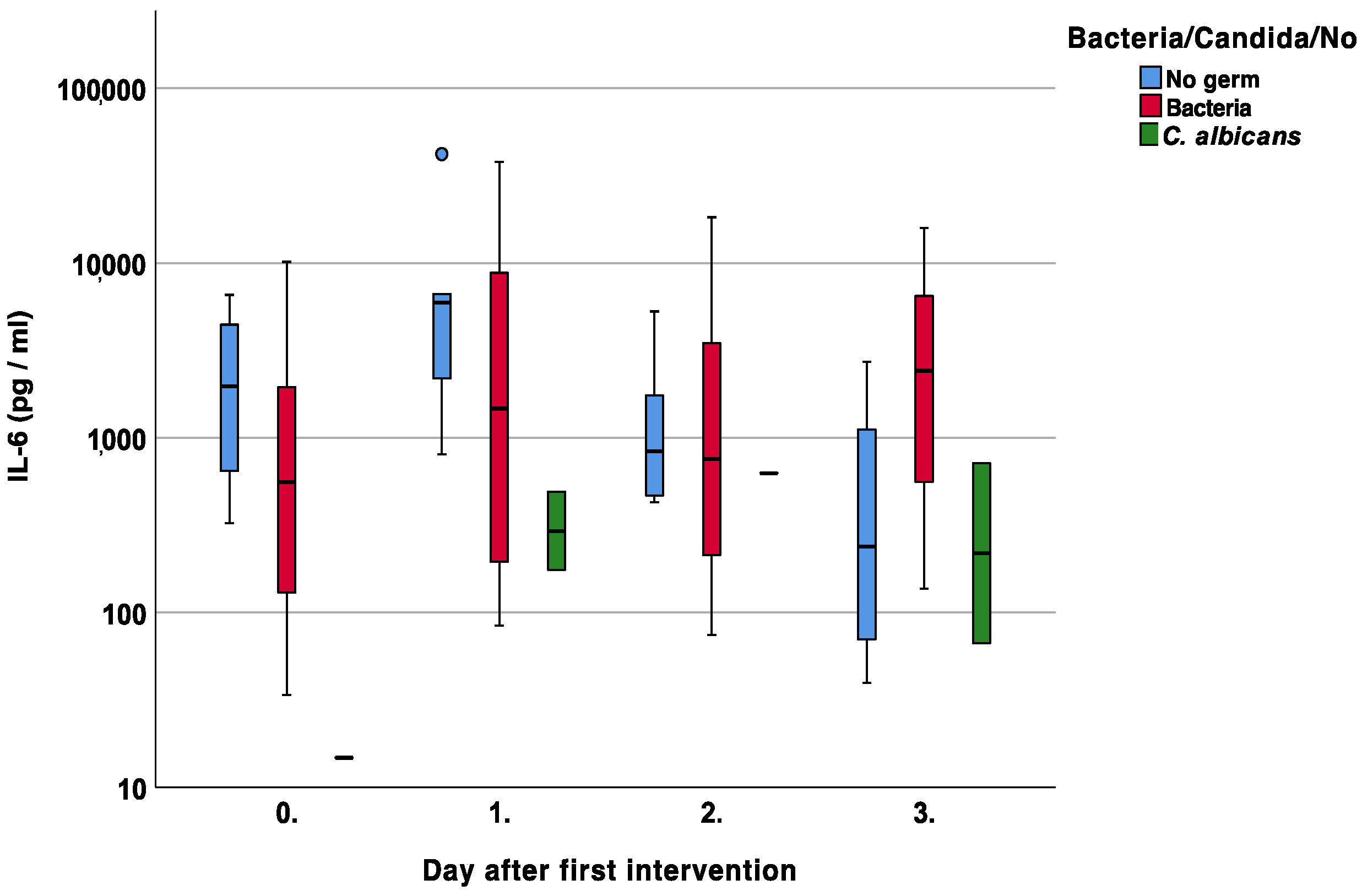
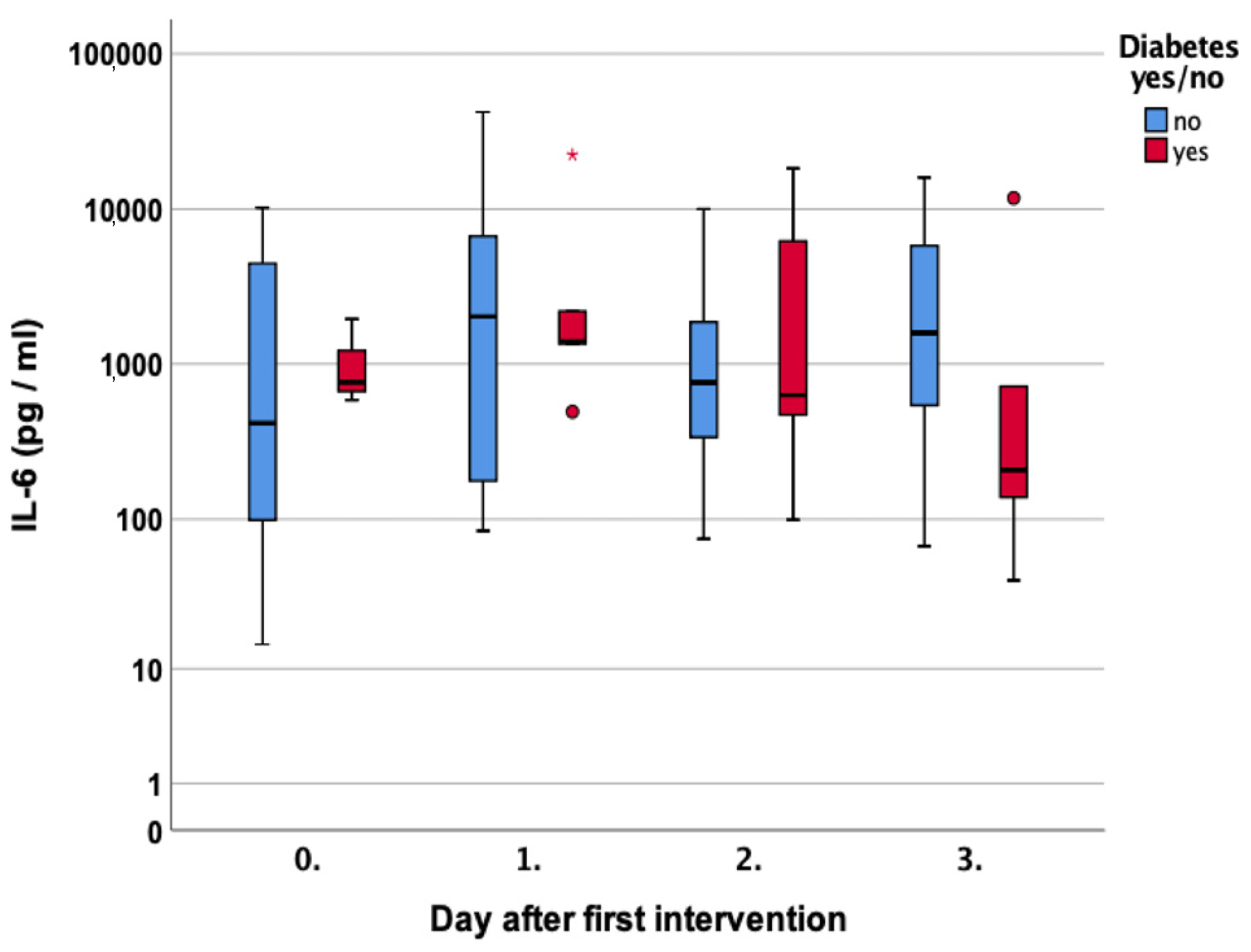
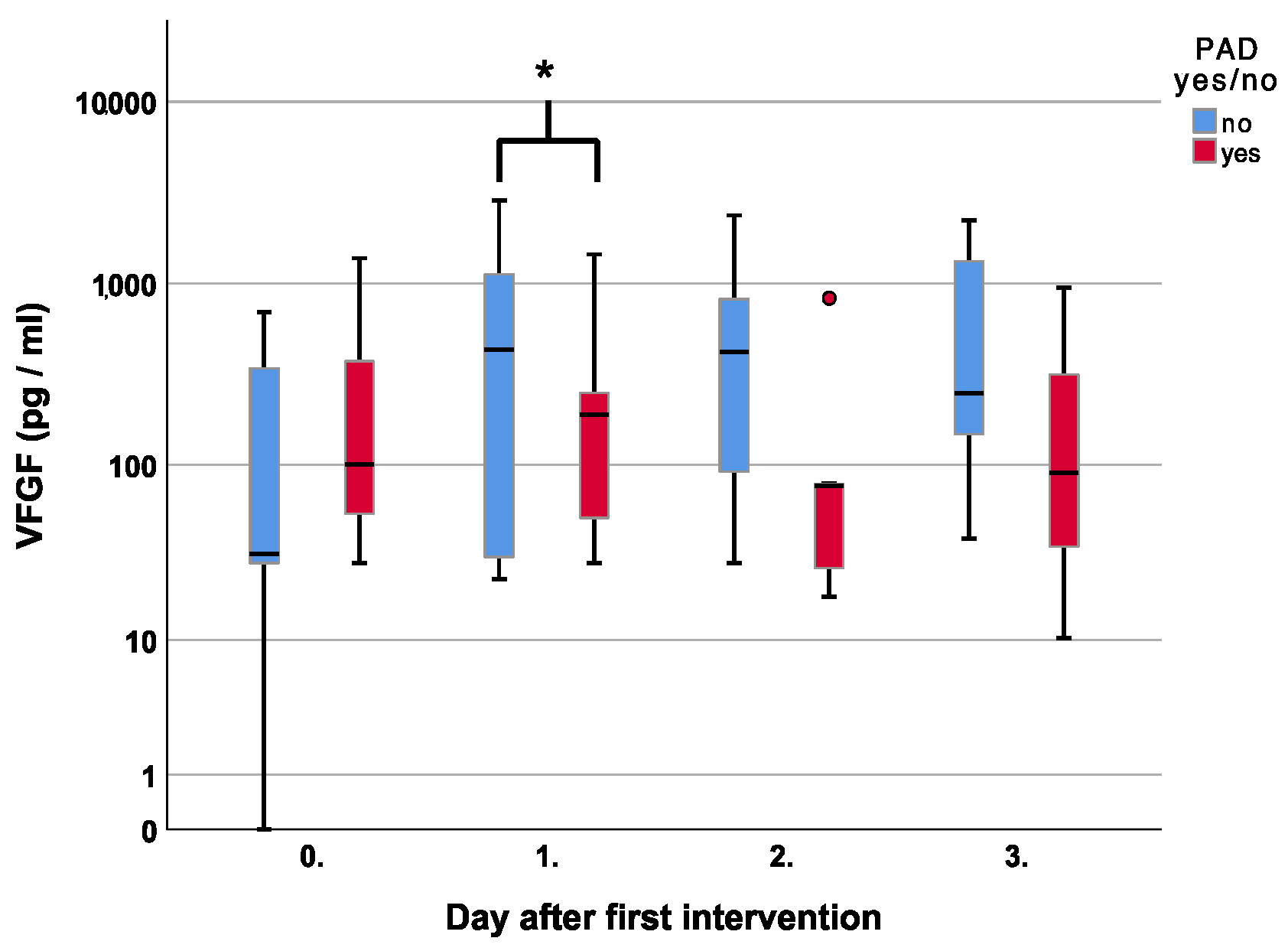
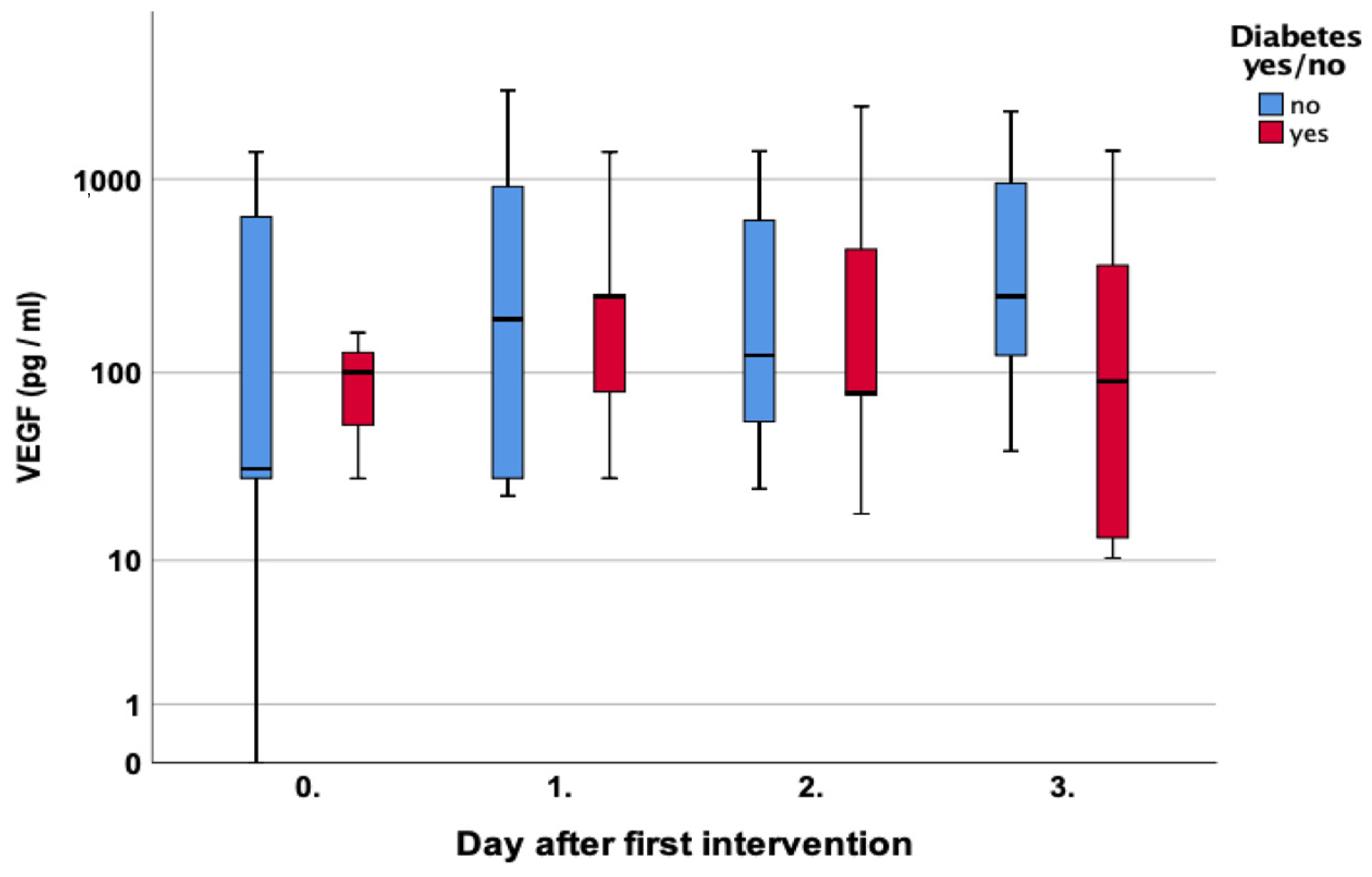
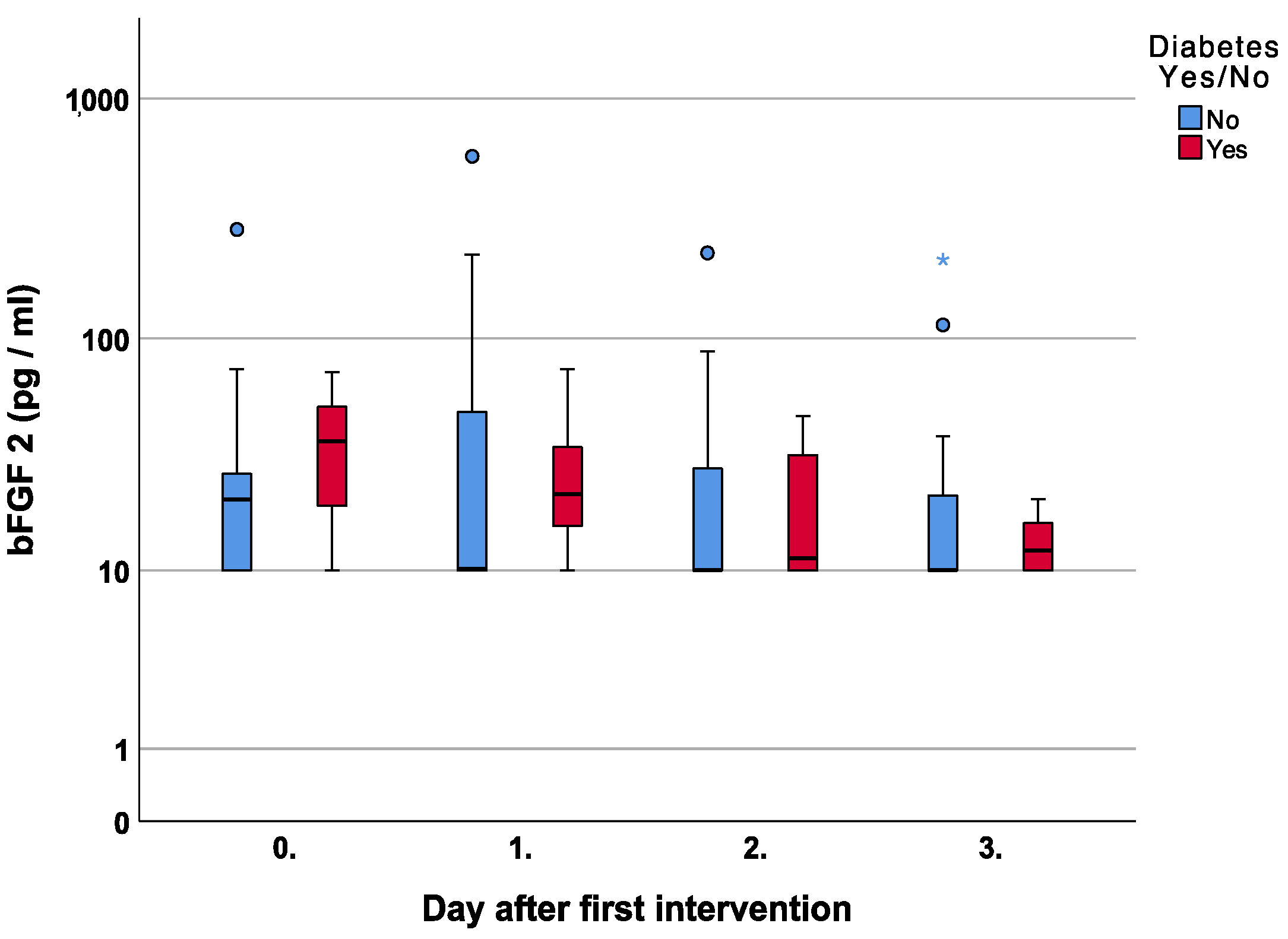


| Patients | |||
| Sex | Male n = 20 | Female n = 11 | |
| Reason | Chronic n = 23 Ischemic n = 2 Post-traumatic/post-infection n = 12 Decubital ulceration n = 6 Carcinoma-associated n = 3 Diabetes = 6 Peripheral Artery Disease = 8 | Acute n= 8 Traumatic n = 4 Ischemic/compartment n = 3 Burns n = 1 | |
| Microbiological contamination | Bacteria S. aureus n = 10 MRSA n = 2 S. epidermidis n = 4 S.pyogenes n = 2 S. anginosus/massilensis n = 1 E. coli n = 3 E. faecalis n = 6 P. aeruginosa n = 3 Proteus spp. n = 4 Klepsiella spp. n = 2 Polymicrobial (≤2) n = 5 Polymicrobial (≥3) n = 2 | Fungus Candida albicans n = 3 | No contamination n = 7 |
Disclaimer/Publisher’s Note: The statements, opinions and data contained in all publications are solely those of the individual author(s) and contributor(s) and not of MDPI and/or the editor(s). MDPI and/or the editor(s) disclaim responsibility for any injury to people or property resulting from any ideas, methods, instructions or products referred to in the content. |
© 2023 by the authors. Licensee MDPI, Basel, Switzerland. This article is an open access article distributed under the terms and conditions of the Creative Commons Attribution (CC BY) license (https://creativecommons.org/licenses/by/4.0/).
Share and Cite
Biermann, N.; Wallner, S.; Martini, T.; Spoerl, S.; Prantl, L.; Taeger, C.D. Negative Pressure Wound Therapy with Instillation: Analysis of the Rinsing Fluid as a Monitoring Tool and Approach to the Inflammatory Process: A Pilot Study. J. Clin. Med. 2023, 12, 711. https://doi.org/10.3390/jcm12020711
Biermann N, Wallner S, Martini T, Spoerl S, Prantl L, Taeger CD. Negative Pressure Wound Therapy with Instillation: Analysis of the Rinsing Fluid as a Monitoring Tool and Approach to the Inflammatory Process: A Pilot Study. Journal of Clinical Medicine. 2023; 12(2):711. https://doi.org/10.3390/jcm12020711
Chicago/Turabian StyleBiermann, Niklas, Stefan Wallner, Teresa Martini, Steffen Spoerl, Lukas Prantl, and Christian D. Taeger. 2023. "Negative Pressure Wound Therapy with Instillation: Analysis of the Rinsing Fluid as a Monitoring Tool and Approach to the Inflammatory Process: A Pilot Study" Journal of Clinical Medicine 12, no. 2: 711. https://doi.org/10.3390/jcm12020711
APA StyleBiermann, N., Wallner, S., Martini, T., Spoerl, S., Prantl, L., & Taeger, C. D. (2023). Negative Pressure Wound Therapy with Instillation: Analysis of the Rinsing Fluid as a Monitoring Tool and Approach to the Inflammatory Process: A Pilot Study. Journal of Clinical Medicine, 12(2), 711. https://doi.org/10.3390/jcm12020711







